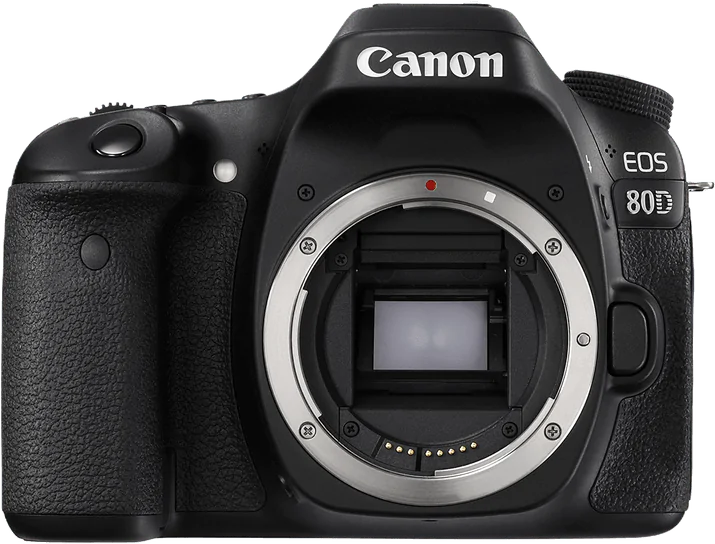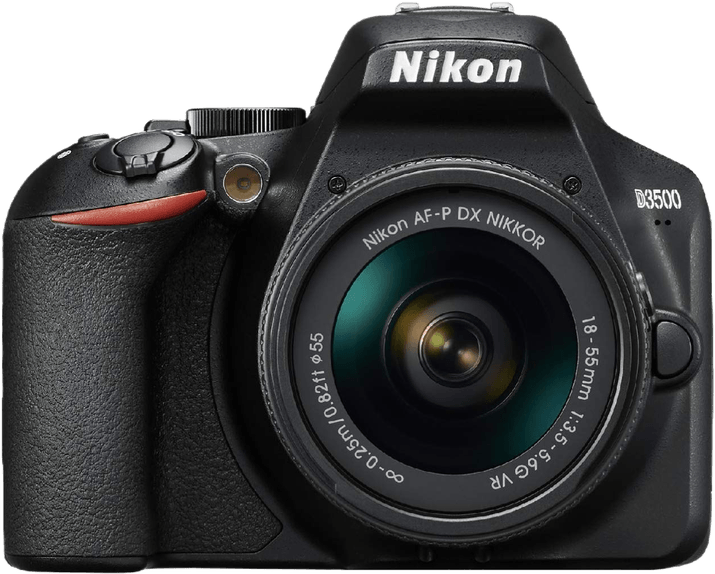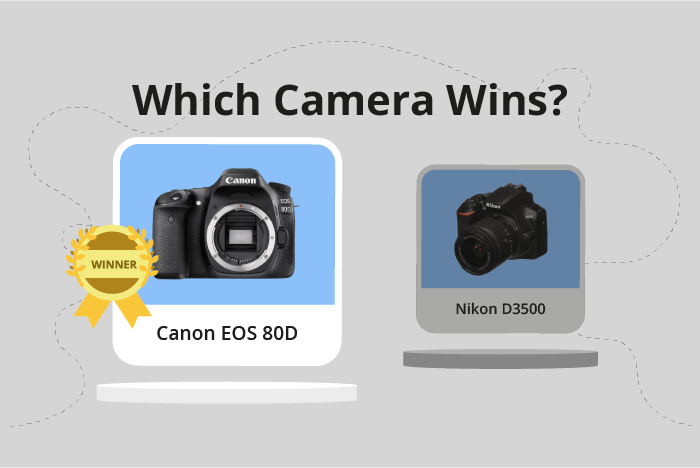Canon EOS 80D vs Nikon D3500 Comparison
Canon EOS 80D

Nikon D3500

The Canon EOS 80D outperforms the Nikon D3500 with a score of 64/100 compared to 61/100. Both cameras are DSLRs launched in 2016 and 2018, respectively. They share similarities in their specifications, such as camera type and general design.
The Canon EOS 80D excels with its higher score, larger size (139 x 105 x 79mm), and heavier weight (730g / 1.61lbs), which may provide a more substantial and professional feel. However, it comes with a higher launch price of $1200.
On the other hand, the Nikon D3500 is more compact (124 x 97 x 70mm) and lighter (615g / 1.36lbs), making it easier to carry and handle. Its launch price is also significantly lower at $499.95.
Considering these points, the Canon EOS 80D may be the better option for those seeking a more professional camera, while the Nikon D3500 is better suited for those looking for a budget-friendly and portable option.
Canon EOS 80D vs Nikon D3500 Overview and Optics
The Nikon D3500 wins in the optics comparison with a score of 65/100, while the Canon EOS 80D scores 63/100. Both cameras share several specifications: 24-megapixel CMOS sensors, APS-C sensor size, lack of image stabilization, and compatibility with their respective brand’s lens mounts (Canon EF-S and Nikon F).
The Nikon D3500 outperforms the Canon EOS 80D in terms of sensor performance, scoring an impressive 87 on the DXOMARK test, compared to the 80D’s 79. This higher score indicates that the D3500’s sensor captures better image quality, specifically in dynamic range, color depth, and low-light performance. However, the 80D has a faster shooting speed of 7 frames per second (fps), compared to the D3500’s 5 fps. This advantage makes the 80D better suited for action photography and capturing fast-moving subjects.
On the other hand, the Canon EOS 80D benefits from a more advanced processor, the Digic 6, while the Nikon D3500 uses the Expeed 4. This results in faster overall performance and improved image processing for the 80D. Additionally, the 80D boasts a slightly higher megapixel count of 24.2, compared to the D3500’s 24, which allows for marginally larger prints and more detailed images.
Considering these factors, the Nikon D3500 offers superior image quality due to its higher DXOMARK sensor score, making it the better choice for photographers prioritizing image quality. However, the Canon EOS 80D’s faster shooting speed and more advanced processor may appeal to action photographers or those seeking quicker overall performance.
Canon EOS 80D vs Nikon D3500 Video Performance
The Canon EOS 80D outperforms the Nikon D3500 in video capabilities, scoring 70/100 compared to the Nikon’s 56/100. Both cameras share common specifications, including Full HD video resolution and maximum video dimensions of 1920 x 1080. They also have the same maximum video frame rate of 60fps.
The Canon EOS 80D has a significant advantage over the Nikon D3500, as it features built-in time-lapse functionality. This allows users to create stunning time-lapse videos without needing additional software or equipment. The Canon’s higher video score reflects its superior performance in this area.
While the Nikon D3500 falls short in comparison to the Canon EOS 80D, it still offers solid video capabilities. Its Full HD resolution and 60fps frame rate enable users to capture quality footage. However, the lack of built-in time-lapse functionality limits its versatility in comparison to the Canon EOS 80D.
Considering these points, the Canon EOS 80D proves to be a better choice for those who prioritize video capabilities. Its built-in time-lapse functionality sets it apart from the Nikon D3500, which lacks this feature. On the other hand, the Nikon D3500 remains a decent option for users who do not require time-lapse functionality and are content with Full HD resolution and a 60fps frame rate.
Canon EOS 80D vs Nikon D3500 Features and Benefits
The Canon EOS 80D is the winner in the features comparison with a score of 70/100, while the Nikon D3500 has a score of 54/100. Both cameras share some common specifications, such as a 3-inch screen size and a lack of GPS. However, there are notable differences that make the Canon EOS 80D a better choice in terms of features.
The Canon EOS 80D has a higher screen resolution of 1,040,000 dots compared to the Nikon D3500’s 921,600 dots. This results in a clearer and sharper screen display. Additionally, the Canon EOS 80D has a touchscreen, making it easier to navigate and control the camera settings. The flip screen is another advantage of the Canon EOS 80D, as it allows for more flexible shooting angles and better self-portraits. Furthermore, the Canon EOS 80D has Wi-Fi connectivity, which enables wireless transfer of photos and remote control of the camera.
On the other hand, the Nikon D3500 has Bluetooth connectivity, which the Canon EOS 80D lacks. This allows for quick and easy sharing of photos with compatible devices. However, this advantage is not enough to outweigh the benefits offered by the Canon EOS 80D’s features.
In comparing the features of these two cameras, the Canon EOS 80D is the better choice due to its higher screen resolution, touchscreen, flip screen, and Wi-Fi connectivity. The Nikon D3500 has the advantage of Bluetooth connectivity, but it falls short in other areas. Therefore, the Canon EOS 80D is the superior option for those seeking a camera with more advanced features.
Canon EOS 80D vs Nikon D3500 Storage and Battery
The Nikon D3500 wins the storage and battery comparison with a score of 48, while the Canon EOS 80D scores 43. Both cameras have one memory card slot, accepting SD, SDHC, and SDXC cards. Neither camera offers USB charging.
The Nikon D3500 outperforms the Canon EOS 80D in battery life, providing 1550 shots per charge with its EN-EL14a battery, compared to the 960 shots offered by the Canon EOS 80D’s LP-E6N battery. This significant difference in battery life makes the Nikon D3500 more reliable for extended shooting sessions.
The Canon EOS 80D, however, has the advantage of being compatible with UHS-I memory cards, allowing for faster read and write speeds. This feature can be beneficial for photographers who require quicker data transfer rates.
Considering these factors, the Nikon D3500 is the better choice for longer battery life, while the Canon EOS 80D offers superior memory card compatibility for faster data transfer.
Canon EOS 80D vs Nikon D3500 – Our Verdict
Are you still undecided about which camera is right for you? Have a look at these popular comparisons that feature the Canon EOS 80D or the Nikon D3500:

